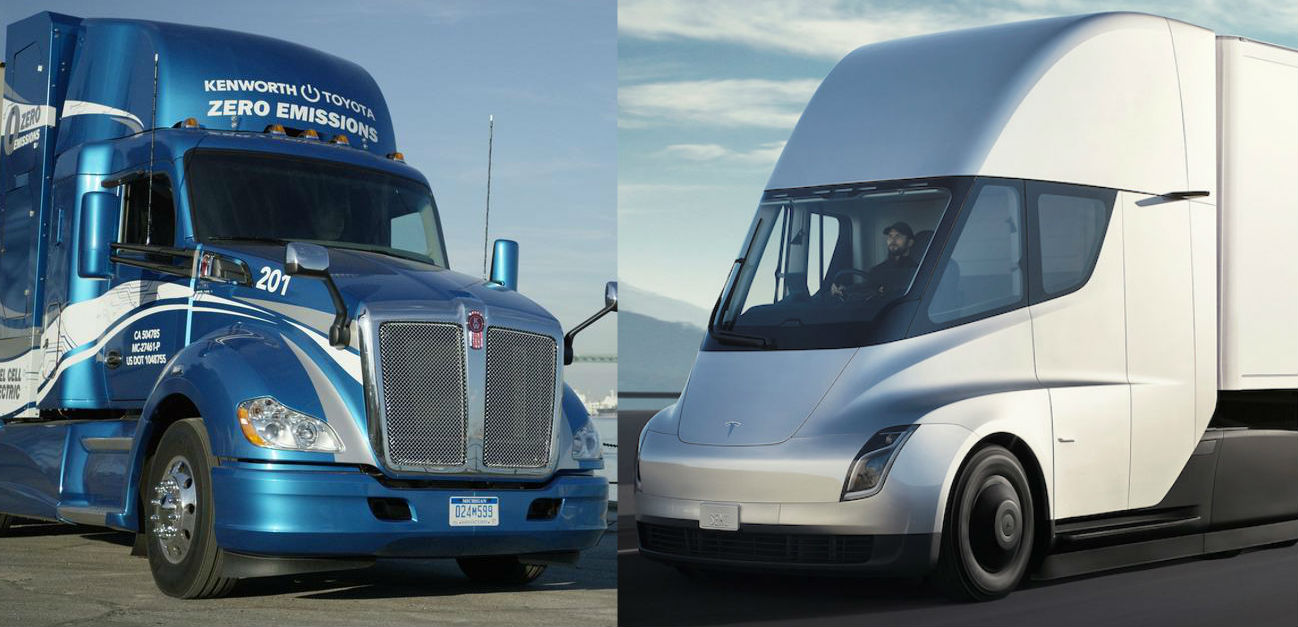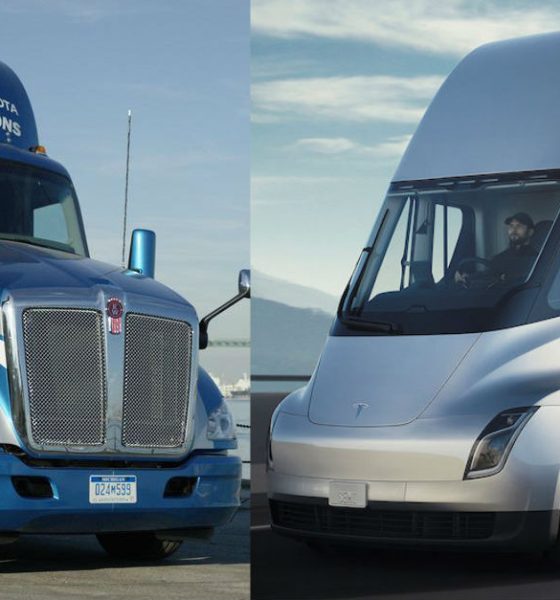

News
Tesla Semi gets ‘peppy and quiet’ hydrogen fuel cell competitor from Kenworth-Toyota
With support from the California Air Resources Board, Japanese auto giant Toyota and truck maker are collaborating to develop and build a limited run of hydrogen fuel trucks. The vehicles, which are Kenworth T680 trucks modified with Toyota’s hydrogen fuel cell powertrains, are expected to drive on routes around Los Angeles and further inland to San Bernardino. The actual specs of the vehicles have not been announced by either company, but the range of the hydrogen fuel cell T680 trucks are said to be 300 miles in “normal drayage operating conditions.”
Toyota and Paccar, the parent company behind Kenworth, took the wraps off the first hydrogen fuel cell long-hauler at this month’s Consumer Electronics Show in Las Vegas. The vehicle, which is classified as a Class 8 truck, stands to be a possible competitor for upcoming all-electric trucks like the Tesla Semi in the future. In a statement to CNBC, Brian Lindgren, Kenworth’s director of research and development, noted that utilizing hydrogen as a source of propulsion makes more sense for Class 8 vehicles than batteries, which power vehicles like Tesla’s all-electric long-hauler.
“We believe that carrying energy in the form of hydrogen for heavy-duty Class 8 trucks makes more sense than carrying it in batteries because the trucks can be refilled faster and offer longer range,” he said.
Lindgren’s point about faster refilling times for hydrogen fuel cell vehicles is quite justified, considering that a passenger car such as a Toyota Mirai could refill its tank with around 300 miles of range in roughly five minutes. That’s significantly faster than Tesla’s Superchargers, which are capable of charging roughly 200 miles of range in 30 minutes. Larger vehicles such as the hydrogen-electric Kenworth T680 trucks would likely take longer to refill than a passenger car such as the Mirai, but there’s a good chance that the long-hauler could still refill its tank faster than the Tesla Semi could charge its batteries, even if it is plugged into the upcoming Megacharger Network.
Toyota-Paccar’s Kenworth T680 hybrid fuel cell trucks caught the attention of some CES attendees due to the vehicle’s silent operation, which is nearly comparable to an all-electric truck. Lindgren, for his part, noted that drivers who have operated the truck actually appreciated the silence of the vehicle. “Drivers like these trucks because they are peppy and quiet,” he said.
Andy Lund, the Toyota chief engineer on the project, further stated that the hydrogen-electric trucks would have the same payload capacity as a diesel rig. Unlike its fossil fuel-powered counterparts, the hydrogen fuel cell Kenworth T680 long-haulers would only require a four-speed transmission, which is far simpler than the 18-gear transmissions usually fitted on Class 8 diesel trucks.
If there is one thing that would probably go against Toyota and Paccar’s hydrogen trucks, though, it would be their fuel efficiency. Kenworth’s director of research and development noted that the prototype trucks currently consume hydrogen at roughly the same rate as present diesel trucks, at around 5-7 mpg. The only advantage of the vehicles, of course, is that the trucks would only produce water vapor from their exhausts. This is a substantial advantage, considering that the trucking industry accounts for about 23% of carbon emissions from transportation in 2016, according to the Environmental Protection Agency.
That said, this would be something that Tesla could capitalize on. During the electric long-hauler’s unveiling, Musk noted that the Semi would cost operators $1.26 per mile to run, less than the standard $1.51 per mile that diesel-powered vehicles cost. Musk’s estimate has been met by skepticism by veterans of the trucking industry, but if the Tesla Semi’s operating costs stay true to the CEO’s estimate, then the vehicle would most certainly give itself a notable advantage over diesel and hydrogen-powered rivals when it starts operating on America’s roads.
Hydrogen fuel cells remain a polarizing solution for sustainable transportation. Elon Musk, for one, has openly discussed his dislike for hydrogen-electric transportation. In a statement to Autocar in 2014, for one, Musk went so far as to describe hydrogen fuel cell systems as “mind-bogglingly stupid.”
“They’re mind-bogglingly stupid. You can’t even have a sensible debate. Consider the whole fuel cell system against a Model S. It’s far worse in volume and mass terms, and far, far, worse in cost. And I haven’t even talked about hydrogen being so hard to handle. Success is simply not possible. Manufacturers do it [FCEVs] because they’re under pressure to show they’re doing something ‘constructive’ about sustainability. They feel it’s better to be working on a solution a generation away rather than something just around the corner. Hydrogen is always labeled the fuel of the future – and always will be,” Musk said.
Elon Musk initially announced that the Tesla Semi would start production sometime in 2019. That said, later statements from Tesla’s head of investor relations Martin Viecha suggested that the electric car maker would “earnestly” start producing the Semi by 2020.

Elon Musk
SpaceX issues statement on Starship V3 Booster 18 anomaly
The incident unfolded during gas-system pressure testing at the company’s Massey facility in Starbase, Texas.

SpaceX has issued an initial statement about Starship Booster 18’s anomaly early Friday. The incident unfolded during gas-system pressure testing at the company’s Massey facility in Starbase, Texas.
SpaceX’s initial comment
As per SpaceX in a post on its official account on social media platform X, Booster 18 was undergoing gas system pressure tests when the anomaly happened. Despite the nature of the incident, the company emphasized that no propellant was loaded, no engines were installed, and personnel were kept at a safe distance from the booster, resulting in zero injuries.
“Booster 18 suffered an anomaly during gas system pressure testing that we were conducting in advance of structural proof testing. No propellant was on the vehicle, and engines were not yet installed. The teams need time to investigate before we are confident of the cause. No one was injured as we maintain a safe distance for personnel during this type of testing. The site remains clear and we are working plans to safely reenter the site,” SpaceX wrote in its post on X.
Incident and aftermath
Livestream footage from LabPadre showed Booster 18’s lower half crumpling around the liquid oxygen tank area at approximately 4:04 a.m. CT. Subsequent images posted by on-site observers revealed extensive deformation across the booster’s lower structure. Needless to say, spaceflight observers have noted that Booster 18 would likely be a complete loss due to its anomaly.
Booster 18 had rolled out only a day earlier and was one of the first vehicles in the Starship V3 program. The V3 series incorporates structural reinforcements and reliability upgrades intended to prepare Starship for rapid-reuse testing and eventual tower-catch operations. Elon Musk has been optimistic about Starship V3, previously noting on X that the spacecraft might be able to complete initial missions to Mars.
Investor's Corner
Tesla analyst maintains $500 PT, says FSD drives better than humans now
The team also met with Tesla leaders for more than an hour to discuss autonomy, chip development, and upcoming deployment plans.

Tesla (NASDAQ:TSLA) received fresh support from Piper Sandler this week after analysts toured the Fremont Factory and tested the company’s latest Full Self-Driving software. The firm reaffirmed its $500 price target, stating that FSD V14 delivered a notably smooth robotaxi demonstration and may already perform at levels comparable to, if not better than, average human drivers.
The team also met with Tesla leaders for more than an hour to discuss autonomy, chip development, and upcoming deployment plans.
Analysts highlight autonomy progress
During more than 75 minutes of focused discussions, analysts reportedly focused on FSD v14’s updates. Piper Sandler’s team pointed to meaningful strides in perception, object handling, and overall ride smoothness during the robotaxi demo.
The visit also included discussions on updates to Tesla’s in-house chip initiatives, its Optimus program, and the growth of the company’s battery storage business. Analysts noted that Tesla continues refining cost structures and capital expenditure expectations, which are key elements in future margin recovery, as noted in a Yahoo Finance report.
Analyst Alexander Potter noted that “we think FSD is a truly impressive product that is (probably) already better at driving than the average American.” This conclusion was strengthened by what he described as a “flawless robotaxi ride to the hotel.”
Street targets diverge on TSLA
While Piper Sandler stands by its $500 target, it is not the highest estimate on the Street. Wedbush, for one, has a $600 per share price target for TSLA stock.
Other institutions have also weighed in on TSLA stock as of late. HSBC reiterated a Reduce rating with a $131 target, citing a gap between earnings fundamentals and the company’s market value. By contrast, TD Cowen maintained a Buy rating and a $509 target, pointing to strong autonomous driving demonstrations in Austin and the pace of software-driven improvements.
Stifel analysts also lifted their price target for Tesla to $508 per share over the company’s ongoing robotaxi and FSD programs.
Elon Musk
SpaceX Starship Version 3 booster crumples in early testing
Photos of the incident’s aftermath suggest that Booster 18 will likely be retired.

SpaceX’s new Starship first-stage booster, Booster 18, suffered major damage early Friday during its first round of testing in Starbase, Texas, just one day after rolling out of the factory.
Based on videos of the incident, the lower section of the rocket booster appeared to crumple during a pressurization test. Photos of the incident’s aftermath suggest that Booster 18 will likely be retired.
Booster test failure
SpaceX began structural and propellant-system verification tests on Booster 18 Thursday night at the Massey’s Test Site, only a few miles from Starbase’s production facilities, as noted in an Ars Technica report. At 4:04 a.m. CT on Friday, a livestream from LabPadre Space captured the booster’s lower half experiencing a sudden destructive event around its liquid oxygen tank section. Post-incident images, shared on X by @StarshipGazer, showed notable deformation in the booster’s lower structure.
Neither SpaceX nor Elon Musk had commented as of Friday morning, but the vehicle’s condition suggests it is likely a complete loss. This is quite unfortunate, as Booster 18 is already part of the Starship V3 program, which includes design fixes and upgrades intended to improve reliability. While SpaceX maintains a rather rapid Starship production line in Starbase, Booster 18 was generally expected to validate the improvements implemented in the V3 program.
Tight deadlines
SpaceX needs Starship boosters and upper stages to begin demonstrating rapid reuse, tower catches, and early operational Starlink missions over the next two years. More critically, NASA’s Artemis program depends on an on-orbit refueling test in the second half of 2026, a requirement for the vehicle’s expected crewed lunar landing around 2028.
While SpaceX is known for diagnosing failures quickly and returning to testing at unmatched speed, losing the newest-generation booster at the very start of its campaign highlights the immense challenge involved in scaling Starship into a reliable, high-cadence launch system. SpaceX, however, is known for getting things done quickly, so it would not be a surprise if the company manages to figure out what happened to Booster 18 in the near future.








